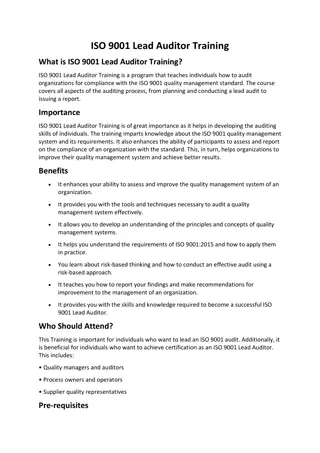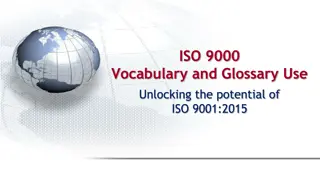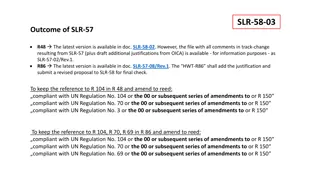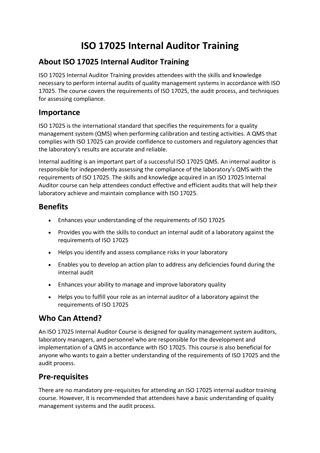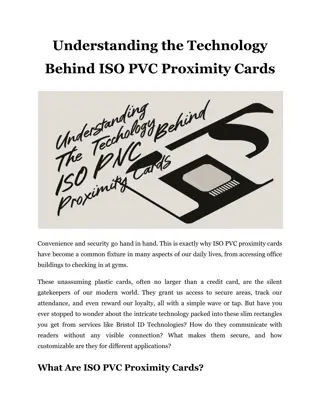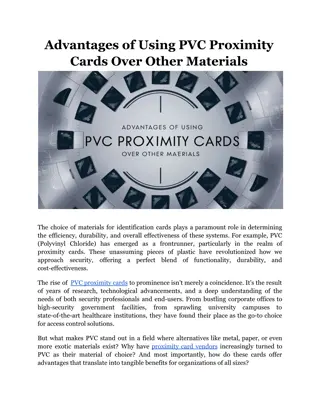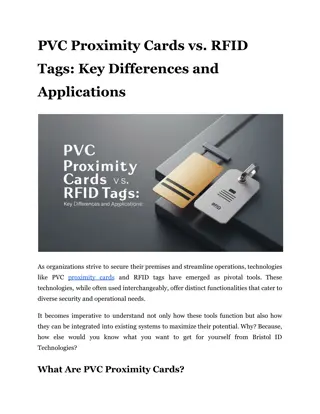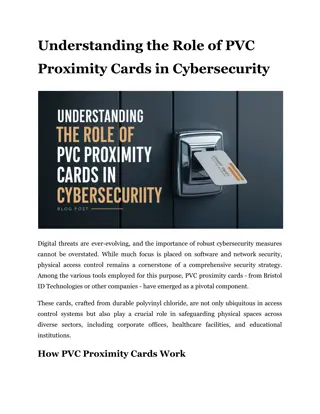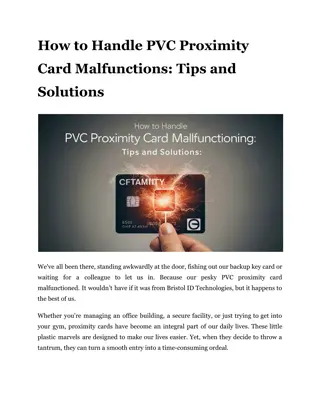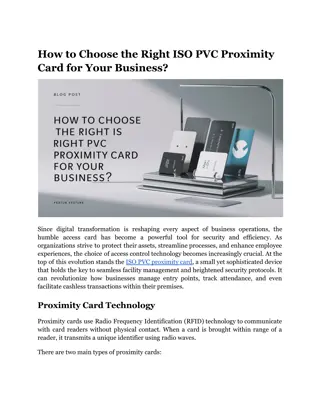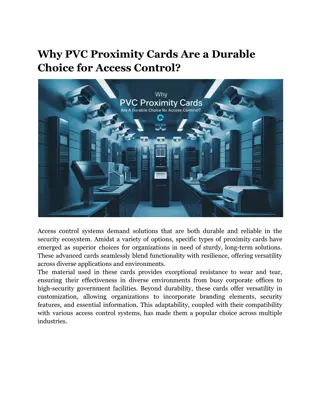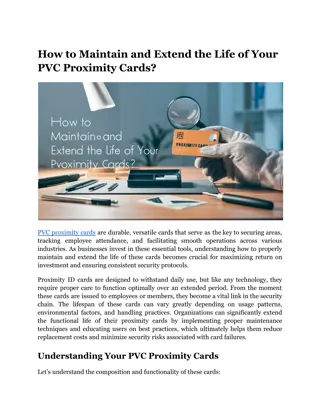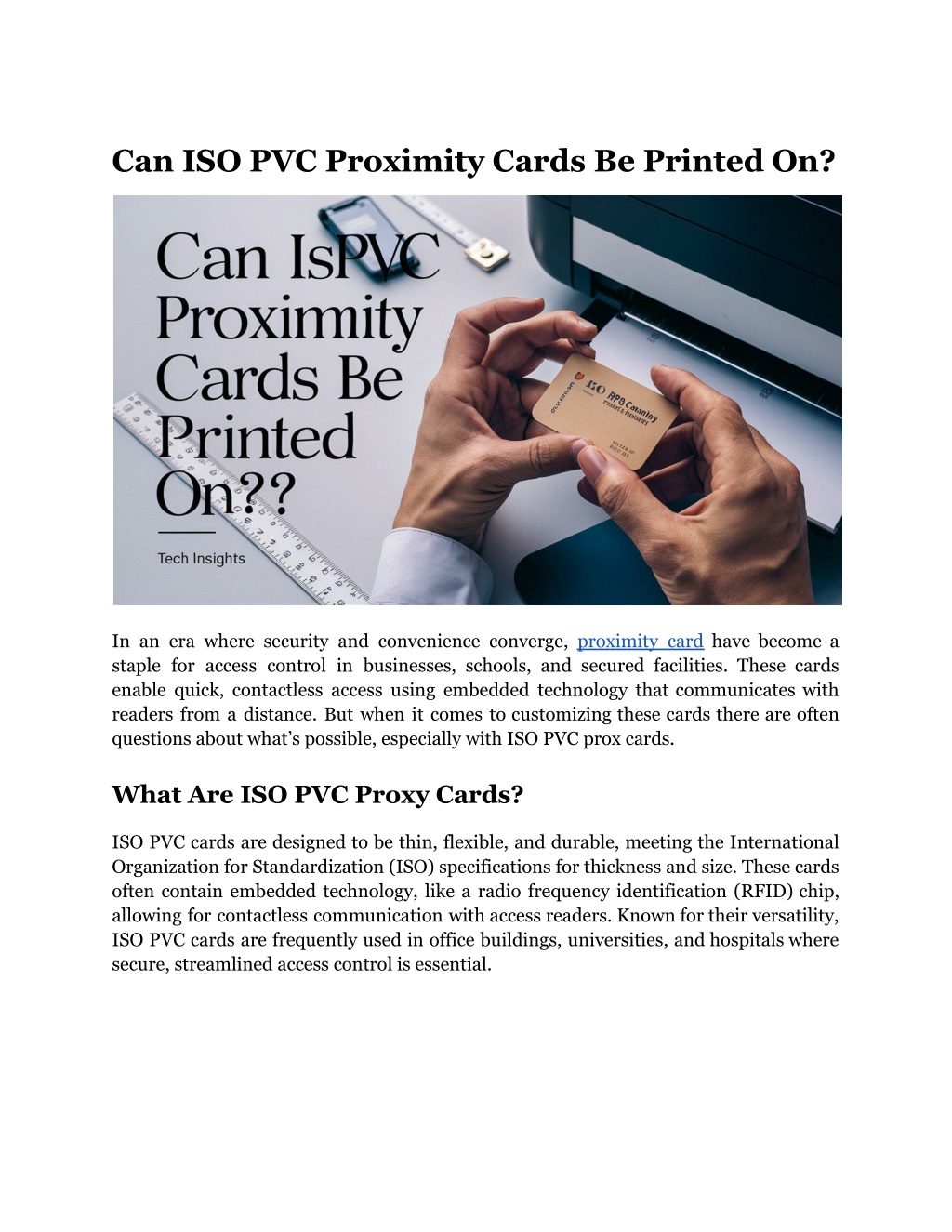
Can ISO PVC Proximity Cards Be Printed On_
Discover if ISO PVC proximity cards can be printed on and learn the best methods to personalize your access control solutions.
Download Presentation

Please find below an Image/Link to download the presentation.
The content on the website is provided AS IS for your information and personal use only. It may not be sold, licensed, or shared on other websites without obtaining consent from the author. Download presentation by click this link. If you encounter any issues during the download, it is possible that the publisher has removed the file from their server.
E N D
Presentation Transcript
Can ISO PVC Proximity Cards Be Printed On? In an era where security and convenience converge, proximity card have become a staple for access control in businesses, schools, and secured facilities. These cards enable quick, contactless access using embedded technology that communicates with readers from a distance. But when it comes to customizing these cards there are often questions about what s possible, especially with ISO PVC prox cards. What Are ISO PVC Proxy Cards? ISO PVC cards are designed to be thin, flexible, and durable, meeting the International Organization for Standardization (ISO) specifications for thickness and size. These cards often contain embedded technology, like a radio frequency identification (RFID) chip, allowing for contactless communication with access readers. Known for their versatility, ISO PVC cards are frequently used in office buildings, universities, and hospitals where secure, streamlined access control is essential.
Types of Printing Available for Prox Cards Proxy cards can be printed on, but the type of printing depends on the card s specifications and embedded technology. Typically, printing on an ISO PVC card falls into one of these categories: Direct-to-Card Printing: Uses dye-sublimation or thermal transfer to print directly onto the card s surface. This is common for HID prox card. Re-Transfer Printing: Transfers an image from a film to the card, offering high durability and quality. UV Printing: Utilizes UV ink to add vibrant designs that resist fading and wear. Benefits of Custom Printing on Prox Cards Custom printing enhances the functionality and security of cards, making them useful beyond mere access control. Here s why printing on these cards can add value: Identification: Printed employee photos, names, or departments streamline access and add a layer of visual verification. Branding: Logos and corporate branding add professionalism and consistency to any access card. Security: Custom designs make duplicating or counterfeiting the cards more difficult. Multi-Purpose Use: Printed cards can double as ID badges, payment cards (for compatible systems), and more. Can All Proximity Cards Be Printed On? Not every prox card can be printed on effectively, and the options depend on the card s thickness, material, and embedded technology. Cards containing RFID chips, antennas, or magnetic strips require special handling. Generally, ISO PVC proximity card and some types of HID cards are designed with print-friendly surfaces, but it s important to confirm compatibility before attempting any customization. Factors to Consider Before Printing on Prox Cards 1. Material Composition The core material of the card, typically PVC or composite PVC-PET, affects print durability and quality. PVC is standard and compatible with most card printers, while
composite cards, made with a PVC-PET blend, withstand more intensive wear but may require specialized printers. 2. Card Thickness and Embedded Technology ISO standards for card thickness ensure compatibility with most ID printers. However, embedded technology, such as antennas and chips, can sometimes create an uneven surface, affecting print quality. For complex cards, re-transfer or UV printing methods might be more effective as they avoid direct contact with the card s surface. 3. Printer Compatibility Not all printers handle cards well, so you ll need to verify that your printer is compatible with the type of card you re using. Direct-to-card printers are often compatible with HID prox cards but may not handle thicker or dual-interface cards. Printer settings, ribbon type, and cleaning maintenance all influence the final print quality of a card. Printer Type Print Method Compatible Prox Cards with Notes Direct-to-Card Printers Dye-Sublima tion Generally compatible Suitable for PVC, less so for composite cards Re-Transfer Printers Re-Transfer Film Highly compatible Ideal for cards with uneven surfaces UV Printers UV Ink Compatible with many types Adds fade-resistant prints durability, 4. Desired Print Quality and Durability For environments where cards are exposed to sunlight, water, or rough handling, opt for durable printing methods like UV or re-transfer, which resist fading and abrasion. These methods offer a longer-lasting finish and are suitable for high-wear use in settings like warehouses or outdoor facilities. Steps for Printing on ISO PVC Cards Printing on prox cards requires proper setup and an understanding of printer settings. Here s a general guide to ensure effective results:
1. Choose the Right Printer and Ink: Ensure compatibility with prox cards, especially for cards with embedded RFID technology. 2. Use High-Quality Card Templates: Design templates should align with the card size and include space for the chip, magnetic stripe, or any embedded elements. 3. Set Printer for Low Heat: High heat settings can damage cards. Reduce the temperature to avoid warping. 4. Test on a Sample Card First: Before mass printing, test a sample card to check alignment, ink adherence, and image clarity. Limitations of Printing on Cards While printing adds functionality and aesthetics, there are some limitations when printing on prox cards: Risk of Damage to Embedded Technology: Excessive heat or pressure can damage the internal components of proxy cards. Limited Surface Area: Cards with large chips, antennas, or magnetic strips may have less printable space. Potential for Fading: Basic dye-sublimation prints may fade faster, especially under direct sunlight. UV or overlay laminates can help mitigate this issue. Cost Considerations: Is Printing on Prox Cards Worth It? The costs associated with printing prox cards vary based on printing method, volume, and durability requirements. Here s a rough breakdown of cost factors: Direct-to-Card Printing: Lowest cost per card but shorter lifespan. Re-Transfer Printing: Slightly higher per-card cost but durable and high quality. UV Printing: Typically the highest cost but offers the best fade resistance and clarity. Printing Method Average Cost per Card Durabili ty Best For Direct-to-Card $0.50 - $1.50 Moderate Basic, indoor ID cards
Re-Transfer $1.50 - $3.00 High High-traffic environments UV Printing $2.00 - $4.50 Very High Long-lasting, use outdoor These factors make it important to balance the cost of customization with the card s intended usage and environment. Choosing the Right Card Manufacturer When sourcing prox cards, it s essential to work with experienced proximity card manufacturers who understand your printing requirements. Many manufacturers provide ISO PVC prox cards designed to handle high-quality printing, ensuring compatibility with various printer types and durability requirements. Reliable manufacturers offer cards that come pre-tested for print adherence and quality. Here s what to look for in a manufacturer: Print Compatibility: Cards should be specified as print-ready with a smooth, uniform surface. Technology Options: Look for options like magnetic stripe encoding, RFID chips, and dual-frequency capabilities. Durability Assurance: Check if the cards are tested for durability, especially if you require high wear resistance. Wrap Up Beyond access control, custom printing transforms each card into a piece of your brand, offering both security and style in one streamlined solution. Make your proximity cards work smarter, not just harder, with a customized, polished finish that leaves a lasting impression. Ready to enhance your security and brand impact with custom-printed prox cards? Bristol ID Technologies specializes in high-quality prox cards that combine robust access control with flawless, customized designs. Get in touch with us today to explore solutions that fit your needs, from secure prox cards to fully branded ID cards that make a statement. Site Article: Can ISO PVC Proximity Cards Be Printed On?



